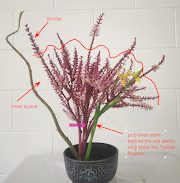Balance 1 - Task
 |

Topic: Balance 1
For more about Balance in ikebana, refer to a short essay, "Introduction to Ikebana Aesthetics" by Dr Shoso Shimbo (available shortly in English & Japanese).
What You Need
How to Make It?
1. Measure the length of container (hight + diameter). If your container's hight is 5cm and diameter is 10cm, the length of your container is 15cm.
2. Prepare the longest leave - 3 X Length of Container. In our example, the longest leave should be about 45cm.
3. Prepare the 2nd Longest leave - about 75% of the longest leave.
4. Prepare the main flower. Adjust its highest so that the leaves and the flower head forms a sharp triangle. See the photo above.
5. Fill unnecessary spaces using fillers, i.e. other flowers or leaves. Those fillers should be smaller or shorter so that the main flower can remain as the focal point. Don’t overuse fillers.
What's Next?
1. Take a photo of your work.
2. Book to join Zoom Ikebana Dojo by 16 June 2020. Use an application form in the page. That is the first step.
3. Join Zoom Ikebana Dojo. Send your photo to our facilitator. Enjoy friendly feedback from our facilitator and other participants.






















